Professional Career Development: Report on Ethical Issues and CPD
VerifiedAdded on 2022/11/28
|8
|2048
|198
Report
AI Summary
This report delves into the critical aspects of preparing for a professional career, focusing on ethical issues within businesses and the significance of a code of conduct. The report examines various ethical dilemmas such as corruption, human rights, and corporate governance, highlighting the role of a code of conduct in establishing a strong foundation of trust and guiding employee behavior. It provides examples of how companies like Coca-Cola and Marks & Spencer implement codes of conduct to address ethical challenges and promote responsible business practices. Furthermore, the report discusses the positive and negative assessments of codes of conduct, emphasizing their role in countering corporate corruption and the challenges associated with enforcement. The appendix includes a CPD plan, reflecting on the learning gained and outlining SMART objectives for future career development, emphasizing integrity, professional behavior, and responsible actions in the workplace.
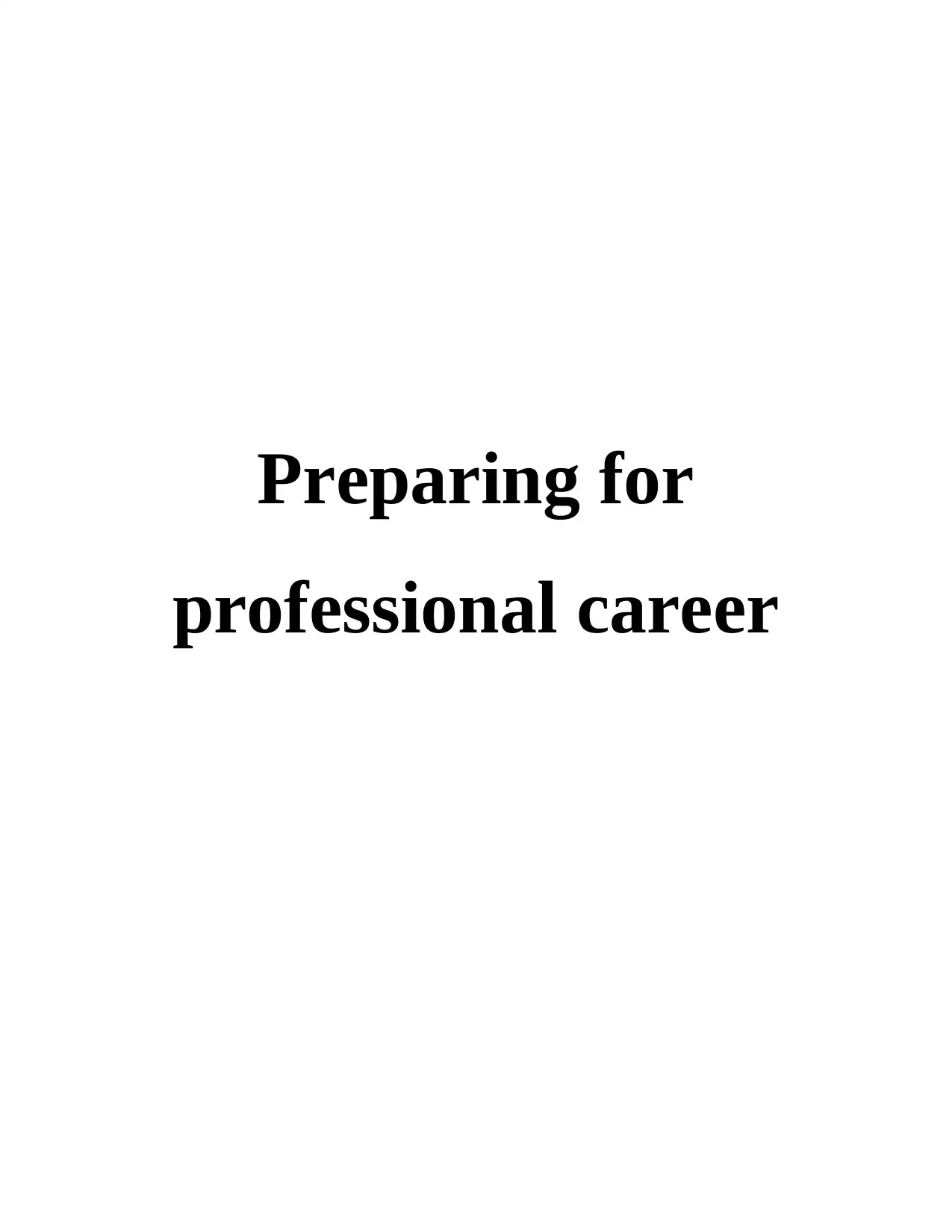
Preparing for
professional career
professional career
Paraphrase This Document
Need a fresh take? Get an instant paraphrase of this document with our AI Paraphraser
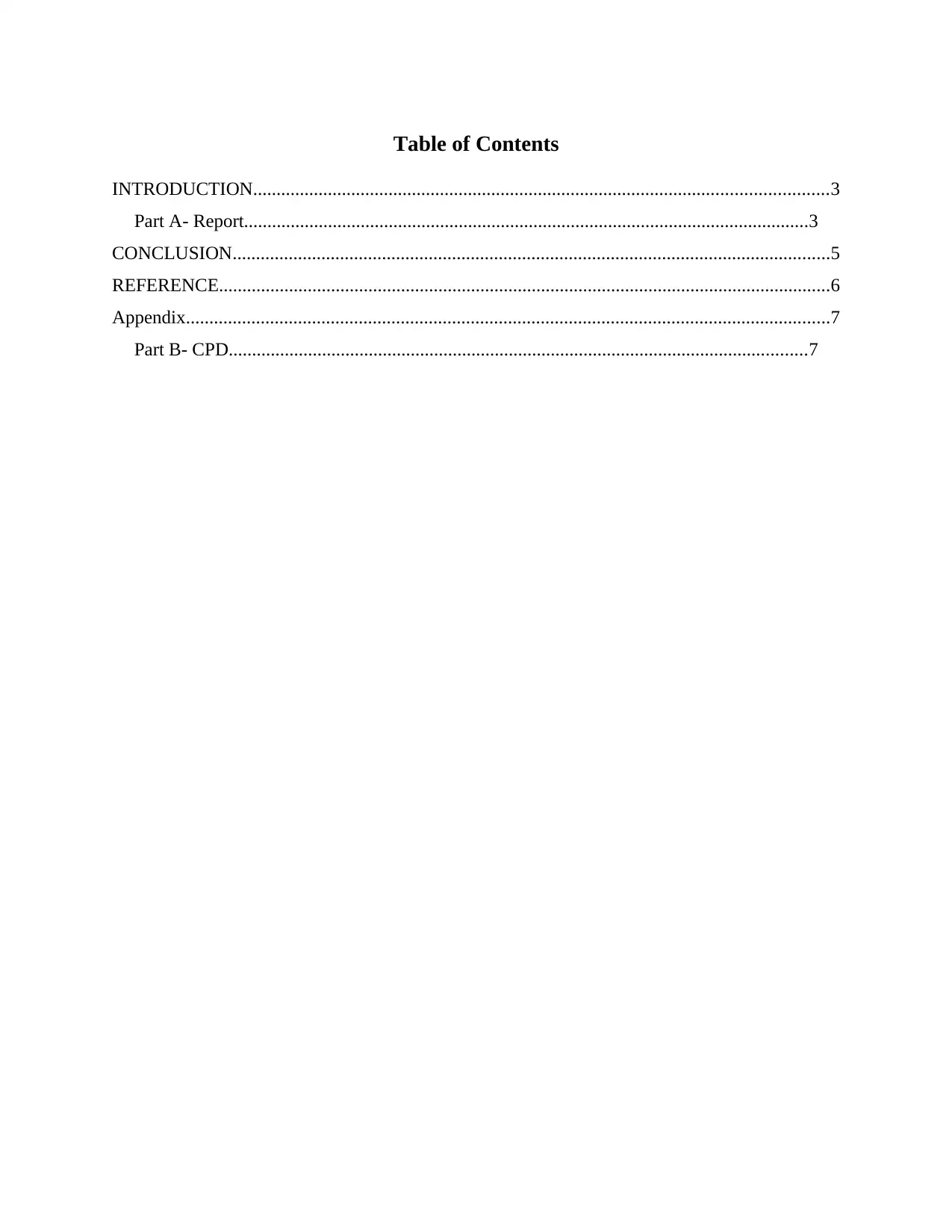
Table of Contents
INTRODUCTION...........................................................................................................................3
Part A- Report.........................................................................................................................3
CONCLUSION................................................................................................................................5
REFERENCE...................................................................................................................................6
Appendix..........................................................................................................................................7
Part B- CPD............................................................................................................................7
INTRODUCTION...........................................................................................................................3
Part A- Report.........................................................................................................................3
CONCLUSION................................................................................................................................5
REFERENCE...................................................................................................................................6
Appendix..........................................................................................................................................7
Part B- CPD............................................................................................................................7
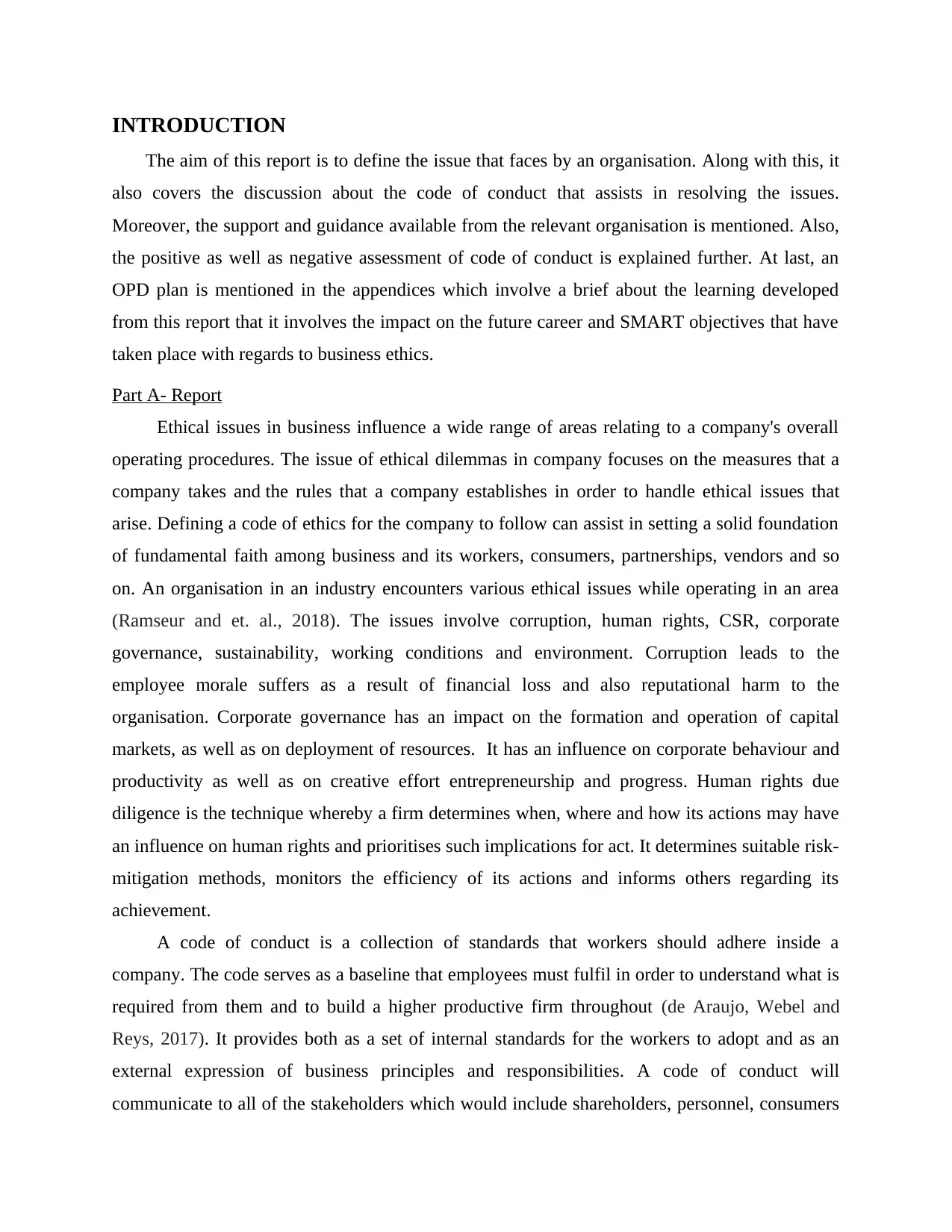
INTRODUCTION
The aim of this report is to define the issue that faces by an organisation. Along with this, it
also covers the discussion about the code of conduct that assists in resolving the issues.
Moreover, the support and guidance available from the relevant organisation is mentioned. Also,
the positive as well as negative assessment of code of conduct is explained further. At last, an
OPD plan is mentioned in the appendices which involve a brief about the learning developed
from this report that it involves the impact on the future career and SMART objectives that have
taken place with regards to business ethics.
Part A- Report
Ethical issues in business influence a wide range of areas relating to a company's overall
operating procedures. The issue of ethical dilemmas in company focuses on the measures that a
company takes and the rules that a company establishes in order to handle ethical issues that
arise. Defining a code of ethics for the company to follow can assist in setting a solid foundation
of fundamental faith among business and its workers, consumers, partnerships, vendors and so
on. An organisation in an industry encounters various ethical issues while operating in an area
(Ramseur and et. al., 2018). The issues involve corruption, human rights, CSR, corporate
governance, sustainability, working conditions and environment. Corruption leads to the
employee morale suffers as a result of financial loss and also reputational harm to the
organisation. Corporate governance has an impact on the formation and operation of capital
markets, as well as on deployment of resources. It has an influence on corporate behaviour and
productivity as well as on creative effort entrepreneurship and progress. Human rights due
diligence is the technique whereby a firm determines when, where and how its actions may have
an influence on human rights and prioritises such implications for act. It determines suitable risk-
mitigation methods, monitors the efficiency of its actions and informs others regarding its
achievement.
A code of conduct is a collection of standards that workers should adhere inside a
company. The code serves as a baseline that employees must fulfil in order to understand what is
required from them and to build a higher productive firm throughout (de Araujo, Webel and
Reys, 2017). It provides both as a set of internal standards for the workers to adopt and as an
external expression of business principles and responsibilities. A code of conduct will
communicate to all of the stakeholders which would include shareholders, personnel, consumers
The aim of this report is to define the issue that faces by an organisation. Along with this, it
also covers the discussion about the code of conduct that assists in resolving the issues.
Moreover, the support and guidance available from the relevant organisation is mentioned. Also,
the positive as well as negative assessment of code of conduct is explained further. At last, an
OPD plan is mentioned in the appendices which involve a brief about the learning developed
from this report that it involves the impact on the future career and SMART objectives that have
taken place with regards to business ethics.
Part A- Report
Ethical issues in business influence a wide range of areas relating to a company's overall
operating procedures. The issue of ethical dilemmas in company focuses on the measures that a
company takes and the rules that a company establishes in order to handle ethical issues that
arise. Defining a code of ethics for the company to follow can assist in setting a solid foundation
of fundamental faith among business and its workers, consumers, partnerships, vendors and so
on. An organisation in an industry encounters various ethical issues while operating in an area
(Ramseur and et. al., 2018). The issues involve corruption, human rights, CSR, corporate
governance, sustainability, working conditions and environment. Corruption leads to the
employee morale suffers as a result of financial loss and also reputational harm to the
organisation. Corporate governance has an impact on the formation and operation of capital
markets, as well as on deployment of resources. It has an influence on corporate behaviour and
productivity as well as on creative effort entrepreneurship and progress. Human rights due
diligence is the technique whereby a firm determines when, where and how its actions may have
an influence on human rights and prioritises such implications for act. It determines suitable risk-
mitigation methods, monitors the efficiency of its actions and informs others regarding its
achievement.
A code of conduct is a collection of standards that workers should adhere inside a
company. The code serves as a baseline that employees must fulfil in order to understand what is
required from them and to build a higher productive firm throughout (de Araujo, Webel and
Reys, 2017). It provides both as a set of internal standards for the workers to adopt and as an
external expression of business principles and responsibilities. A code of conduct will
communicate to all of the stakeholders which would include shareholders, personnel, consumers
⊘ This is a preview!⊘
Do you want full access?
Subscribe today to unlock all pages.

Trusted by 1+ million students worldwide
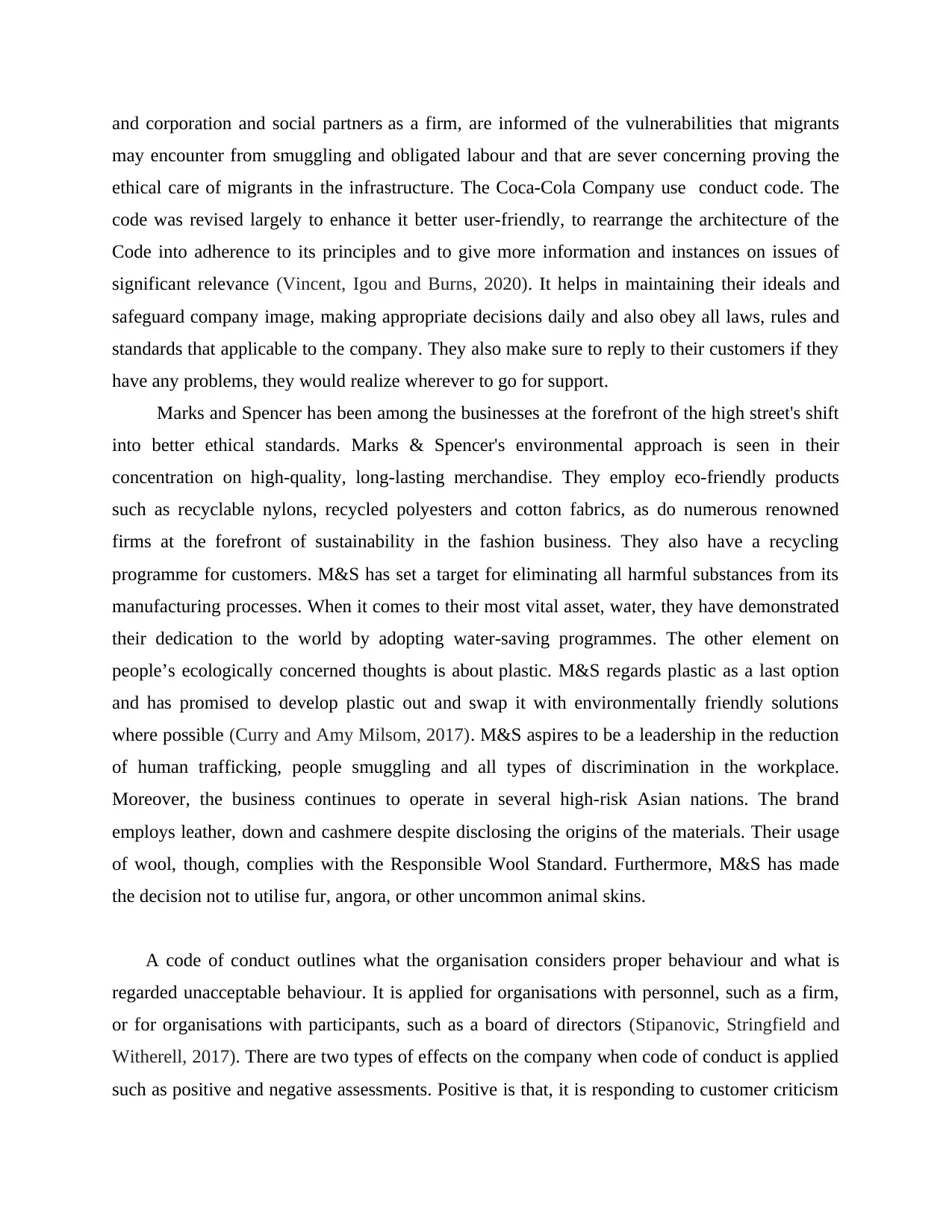
and corporation and social partners as a firm, are informed of the vulnerabilities that migrants
may encounter from smuggling and obligated labour and that are sever concerning proving the
ethical care of migrants in the infrastructure. The Coca-Cola Company use conduct code. The
code was revised largely to enhance it better user-friendly, to rearrange the architecture of the
Code into adherence to its principles and to give more information and instances on issues of
significant relevance (Vincent, Igou and Burns, 2020). It helps in maintaining their ideals and
safeguard company image, making appropriate decisions daily and also obey all laws, rules and
standards that applicable to the company. They also make sure to reply to their customers if they
have any problems, they would realize wherever to go for support.
Marks and Spencer has been among the businesses at the forefront of the high street's shift
into better ethical standards. Marks & Spencer's environmental approach is seen in their
concentration on high-quality, long-lasting merchandise. They employ eco-friendly products
such as recyclable nylons, recycled polyesters and cotton fabrics, as do numerous renowned
firms at the forefront of sustainability in the fashion business. They also have a recycling
programme for customers. M&S has set a target for eliminating all harmful substances from its
manufacturing processes. When it comes to their most vital asset, water, they have demonstrated
their dedication to the world by adopting water-saving programmes. The other element on
people’s ecologically concerned thoughts is about plastic. M&S regards plastic as a last option
and has promised to develop plastic out and swap it with environmentally friendly solutions
where possible (Curry and Amy Milsom, 2017). M&S aspires to be a leadership in the reduction
of human trafficking, people smuggling and all types of discrimination in the workplace.
Moreover, the business continues to operate in several high-risk Asian nations. The brand
employs leather, down and cashmere despite disclosing the origins of the materials. Their usage
of wool, though, complies with the Responsible Wool Standard. Furthermore, M&S has made
the decision not to utilise fur, angora, or other uncommon animal skins.
A code of conduct outlines what the organisation considers proper behaviour and what is
regarded unacceptable behaviour. It is applied for organisations with personnel, such as a firm,
or for organisations with participants, such as a board of directors (Stipanovic, Stringfield and
Witherell, 2017). There are two types of effects on the company when code of conduct is applied
such as positive and negative assessments. Positive is that, it is responding to customer criticism
may encounter from smuggling and obligated labour and that are sever concerning proving the
ethical care of migrants in the infrastructure. The Coca-Cola Company use conduct code. The
code was revised largely to enhance it better user-friendly, to rearrange the architecture of the
Code into adherence to its principles and to give more information and instances on issues of
significant relevance (Vincent, Igou and Burns, 2020). It helps in maintaining their ideals and
safeguard company image, making appropriate decisions daily and also obey all laws, rules and
standards that applicable to the company. They also make sure to reply to their customers if they
have any problems, they would realize wherever to go for support.
Marks and Spencer has been among the businesses at the forefront of the high street's shift
into better ethical standards. Marks & Spencer's environmental approach is seen in their
concentration on high-quality, long-lasting merchandise. They employ eco-friendly products
such as recyclable nylons, recycled polyesters and cotton fabrics, as do numerous renowned
firms at the forefront of sustainability in the fashion business. They also have a recycling
programme for customers. M&S has set a target for eliminating all harmful substances from its
manufacturing processes. When it comes to their most vital asset, water, they have demonstrated
their dedication to the world by adopting water-saving programmes. The other element on
people’s ecologically concerned thoughts is about plastic. M&S regards plastic as a last option
and has promised to develop plastic out and swap it with environmentally friendly solutions
where possible (Curry and Amy Milsom, 2017). M&S aspires to be a leadership in the reduction
of human trafficking, people smuggling and all types of discrimination in the workplace.
Moreover, the business continues to operate in several high-risk Asian nations. The brand
employs leather, down and cashmere despite disclosing the origins of the materials. Their usage
of wool, though, complies with the Responsible Wool Standard. Furthermore, M&S has made
the decision not to utilise fur, angora, or other uncommon animal skins.
A code of conduct outlines what the organisation considers proper behaviour and what is
regarded unacceptable behaviour. It is applied for organisations with personnel, such as a firm,
or for organisations with participants, such as a board of directors (Stipanovic, Stringfield and
Witherell, 2017). There are two types of effects on the company when code of conduct is applied
such as positive and negative assessments. Positive is that, it is responding to customer criticism
Paraphrase This Document
Need a fresh take? Get an instant paraphrase of this document with our AI Paraphraser
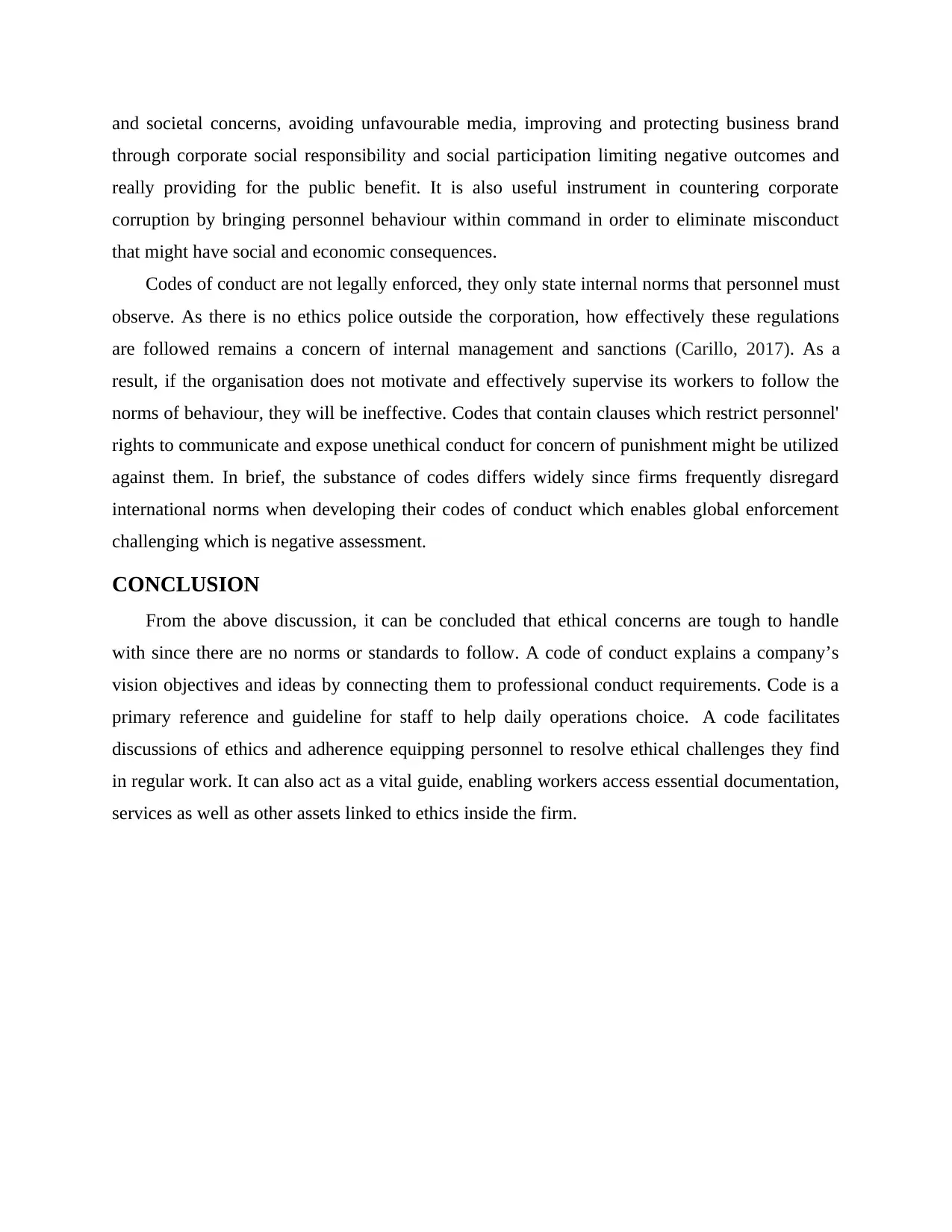
and societal concerns, avoiding unfavourable media, improving and protecting business brand
through corporate social responsibility and social participation limiting negative outcomes and
really providing for the public benefit. It is also useful instrument in countering corporate
corruption by bringing personnel behaviour within command in order to eliminate misconduct
that might have social and economic consequences.
Codes of conduct are not legally enforced, they only state internal norms that personnel must
observe. As there is no ethics police outside the corporation, how effectively these regulations
are followed remains a concern of internal management and sanctions (Carillo, 2017). As a
result, if the organisation does not motivate and effectively supervise its workers to follow the
norms of behaviour, they will be ineffective. Codes that contain clauses which restrict personnel'
rights to communicate and expose unethical conduct for concern of punishment might be utilized
against them. In brief, the substance of codes differs widely since firms frequently disregard
international norms when developing their codes of conduct which enables global enforcement
challenging which is negative assessment.
CONCLUSION
From the above discussion, it can be concluded that ethical concerns are tough to handle
with since there are no norms or standards to follow. A code of conduct explains a company’s
vision objectives and ideas by connecting them to professional conduct requirements. Code is a
primary reference and guideline for staff to help daily operations choice. A code facilitates
discussions of ethics and adherence equipping personnel to resolve ethical challenges they find
in regular work. It can also act as a vital guide, enabling workers access essential documentation,
services as well as other assets linked to ethics inside the firm.
through corporate social responsibility and social participation limiting negative outcomes and
really providing for the public benefit. It is also useful instrument in countering corporate
corruption by bringing personnel behaviour within command in order to eliminate misconduct
that might have social and economic consequences.
Codes of conduct are not legally enforced, they only state internal norms that personnel must
observe. As there is no ethics police outside the corporation, how effectively these regulations
are followed remains a concern of internal management and sanctions (Carillo, 2017). As a
result, if the organisation does not motivate and effectively supervise its workers to follow the
norms of behaviour, they will be ineffective. Codes that contain clauses which restrict personnel'
rights to communicate and expose unethical conduct for concern of punishment might be utilized
against them. In brief, the substance of codes differs widely since firms frequently disregard
international norms when developing their codes of conduct which enables global enforcement
challenging which is negative assessment.
CONCLUSION
From the above discussion, it can be concluded that ethical concerns are tough to handle
with since there are no norms or standards to follow. A code of conduct explains a company’s
vision objectives and ideas by connecting them to professional conduct requirements. Code is a
primary reference and guideline for staff to help daily operations choice. A code facilitates
discussions of ethics and adherence equipping personnel to resolve ethical challenges they find
in regular work. It can also act as a vital guide, enabling workers access essential documentation,
services as well as other assets linked to ethics inside the firm.
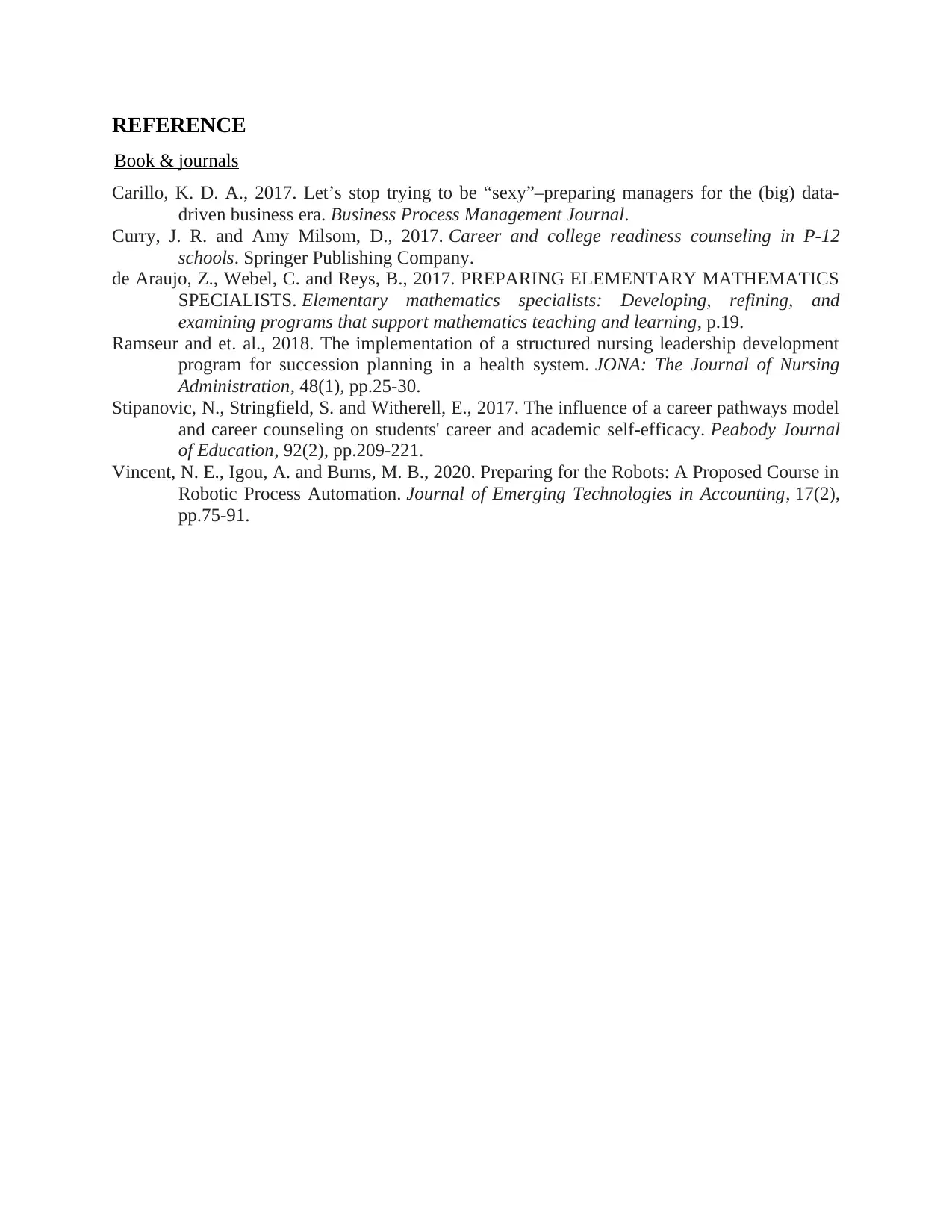
REFERENCE
Book & journals
Carillo, K. D. A., 2017. Let’s stop trying to be “sexy”–preparing managers for the (big) data-
driven business era. Business Process Management Journal.
Curry, J. R. and Amy Milsom, D., 2017. Career and college readiness counseling in P-12
schools. Springer Publishing Company.
de Araujo, Z., Webel, C. and Reys, B., 2017. PREPARING ELEMENTARY MATHEMATICS
SPECIALISTS. Elementary mathematics specialists: Developing, refining, and
examining programs that support mathematics teaching and learning, p.19.
Ramseur and et. al., 2018. The implementation of a structured nursing leadership development
program for succession planning in a health system. JONA: The Journal of Nursing
Administration, 48(1), pp.25-30.
Stipanovic, N., Stringfield, S. and Witherell, E., 2017. The influence of a career pathways model
and career counseling on students' career and academic self-efficacy. Peabody Journal
of Education, 92(2), pp.209-221.
Vincent, N. E., Igou, A. and Burns, M. B., 2020. Preparing for the Robots: A Proposed Course in
Robotic Process Automation. Journal of Emerging Technologies in Accounting, 17(2),
pp.75-91.
Book & journals
Carillo, K. D. A., 2017. Let’s stop trying to be “sexy”–preparing managers for the (big) data-
driven business era. Business Process Management Journal.
Curry, J. R. and Amy Milsom, D., 2017. Career and college readiness counseling in P-12
schools. Springer Publishing Company.
de Araujo, Z., Webel, C. and Reys, B., 2017. PREPARING ELEMENTARY MATHEMATICS
SPECIALISTS. Elementary mathematics specialists: Developing, refining, and
examining programs that support mathematics teaching and learning, p.19.
Ramseur and et. al., 2018. The implementation of a structured nursing leadership development
program for succession planning in a health system. JONA: The Journal of Nursing
Administration, 48(1), pp.25-30.
Stipanovic, N., Stringfield, S. and Witherell, E., 2017. The influence of a career pathways model
and career counseling on students' career and academic self-efficacy. Peabody Journal
of Education, 92(2), pp.209-221.
Vincent, N. E., Igou, A. and Burns, M. B., 2020. Preparing for the Robots: A Proposed Course in
Robotic Process Automation. Journal of Emerging Technologies in Accounting, 17(2),
pp.75-91.
⊘ This is a preview!⊘
Do you want full access?
Subscribe today to unlock all pages.

Trusted by 1+ million students worldwide
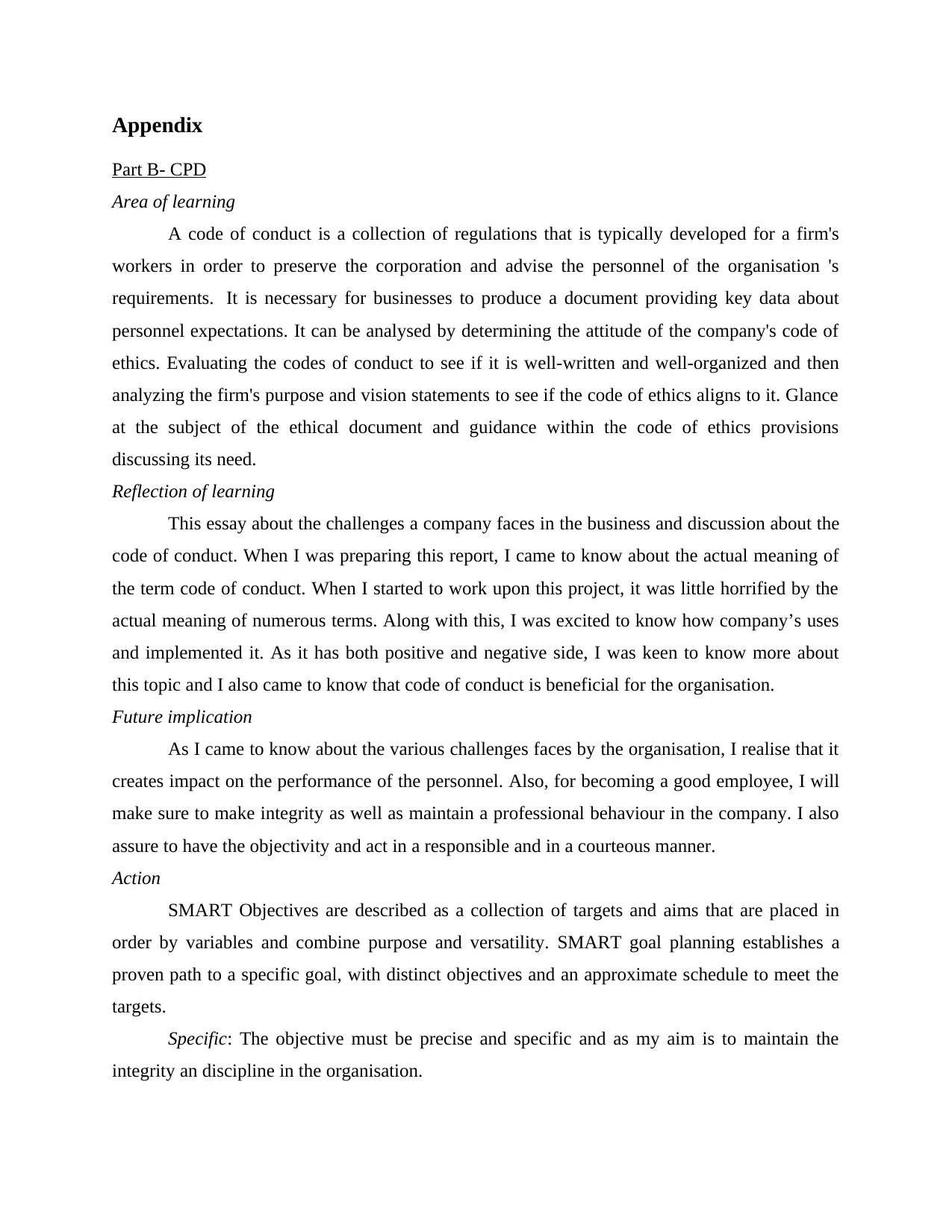
Appendix
Part B- CPD
Area of learning
A code of conduct is a collection of regulations that is typically developed for a firm's
workers in order to preserve the corporation and advise the personnel of the organisation 's
requirements. It is necessary for businesses to produce a document providing key data about
personnel expectations. It can be analysed by determining the attitude of the company's code of
ethics. Evaluating the codes of conduct to see if it is well-written and well-organized and then
analyzing the firm's purpose and vision statements to see if the code of ethics aligns to it. Glance
at the subject of the ethical document and guidance within the code of ethics provisions
discussing its need.
Reflection of learning
This essay about the challenges a company faces in the business and discussion about the
code of conduct. When I was preparing this report, I came to know about the actual meaning of
the term code of conduct. When I started to work upon this project, it was little horrified by the
actual meaning of numerous terms. Along with this, I was excited to know how company’s uses
and implemented it. As it has both positive and negative side, I was keen to know more about
this topic and I also came to know that code of conduct is beneficial for the organisation.
Future implication
As I came to know about the various challenges faces by the organisation, I realise that it
creates impact on the performance of the personnel. Also, for becoming a good employee, I will
make sure to make integrity as well as maintain a professional behaviour in the company. I also
assure to have the objectivity and act in a responsible and in a courteous manner.
Action
SMART Objectives are described as a collection of targets and aims that are placed in
order by variables and combine purpose and versatility. SMART goal planning establishes a
proven path to a specific goal, with distinct objectives and an approximate schedule to meet the
targets.
Specific: The objective must be precise and specific and as my aim is to maintain the
integrity an discipline in the organisation.
Part B- CPD
Area of learning
A code of conduct is a collection of regulations that is typically developed for a firm's
workers in order to preserve the corporation and advise the personnel of the organisation 's
requirements. It is necessary for businesses to produce a document providing key data about
personnel expectations. It can be analysed by determining the attitude of the company's code of
ethics. Evaluating the codes of conduct to see if it is well-written and well-organized and then
analyzing the firm's purpose and vision statements to see if the code of ethics aligns to it. Glance
at the subject of the ethical document and guidance within the code of ethics provisions
discussing its need.
Reflection of learning
This essay about the challenges a company faces in the business and discussion about the
code of conduct. When I was preparing this report, I came to know about the actual meaning of
the term code of conduct. When I started to work upon this project, it was little horrified by the
actual meaning of numerous terms. Along with this, I was excited to know how company’s uses
and implemented it. As it has both positive and negative side, I was keen to know more about
this topic and I also came to know that code of conduct is beneficial for the organisation.
Future implication
As I came to know about the various challenges faces by the organisation, I realise that it
creates impact on the performance of the personnel. Also, for becoming a good employee, I will
make sure to make integrity as well as maintain a professional behaviour in the company. I also
assure to have the objectivity and act in a responsible and in a courteous manner.
Action
SMART Objectives are described as a collection of targets and aims that are placed in
order by variables and combine purpose and versatility. SMART goal planning establishes a
proven path to a specific goal, with distinct objectives and an approximate schedule to meet the
targets.
Specific: The objective must be precise and specific and as my aim is to maintain the
integrity an discipline in the organisation.
Paraphrase This Document
Need a fresh take? Get an instant paraphrase of this document with our AI Paraphraser
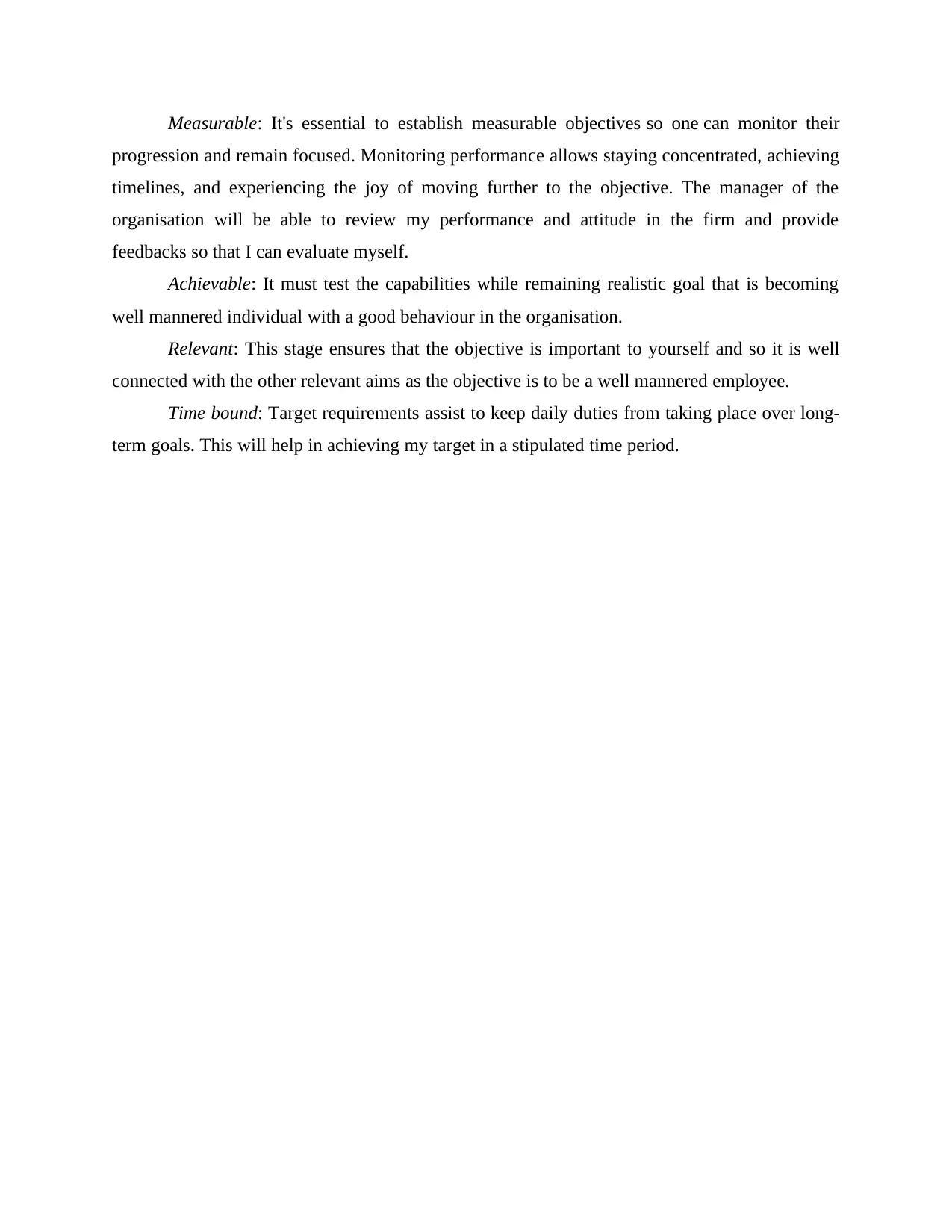
Measurable: It's essential to establish measurable objectives so one can monitor their
progression and remain focused. Monitoring performance allows staying concentrated, achieving
timelines, and experiencing the joy of moving further to the objective. The manager of the
organisation will be able to review my performance and attitude in the firm and provide
feedbacks so that I can evaluate myself.
Achievable: It must test the capabilities while remaining realistic goal that is becoming
well mannered individual with a good behaviour in the organisation.
Relevant: This stage ensures that the objective is important to yourself and so it is well
connected with the other relevant aims as the objective is to be a well mannered employee.
Time bound: Target requirements assist to keep daily duties from taking place over long-
term goals. This will help in achieving my target in a stipulated time period.
progression and remain focused. Monitoring performance allows staying concentrated, achieving
timelines, and experiencing the joy of moving further to the objective. The manager of the
organisation will be able to review my performance and attitude in the firm and provide
feedbacks so that I can evaluate myself.
Achievable: It must test the capabilities while remaining realistic goal that is becoming
well mannered individual with a good behaviour in the organisation.
Relevant: This stage ensures that the objective is important to yourself and so it is well
connected with the other relevant aims as the objective is to be a well mannered employee.
Time bound: Target requirements assist to keep daily duties from taking place over long-
term goals. This will help in achieving my target in a stipulated time period.
1 out of 8
Related Documents
Your All-in-One AI-Powered Toolkit for Academic Success.
+13062052269
info@desklib.com
Available 24*7 on WhatsApp / Email
![[object Object]](/_next/static/media/star-bottom.7253800d.svg)
Unlock your academic potential
Copyright © 2020–2025 A2Z Services. All Rights Reserved. Developed and managed by ZUCOL.





